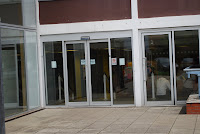Monday, 19 October 2009
Question 1b: Dominant, Absent and Alternative Representations
Question 1b: Representation and Stereotypes
I used this stereotype in my media product in many different ways. The whole idea of animation is that it isn't real and cant be taken to seriously as It is inaccurate information. This is the main reason I used Lego animation as I didn't want my text to be taken to seriously as most Children's TV Dramas aren't. Also the idea of a person changing forms and worlds especially from something that is unreal (animation) to something that is real is very false, but there is a important reason I chose to do this.
Research shows that Children's TV Dramas aimed at an audience between 3-12 are mostly all false information following the same major stereotype I have. I believe this is because children see the world different to us and accept this false information and interpret it into something real. As I have a young target audience and wanting to attract a large audience I decided to follow the same representations and stereotypes like most Children's TV Dramas so I can be mainstream and give the audience a similar effect like other media texts aimed at 5-11 year olds.
I would class my media text to be under many sub genres. Two of the main being Drama and Fantasy. The idea of fantasy is that it isn't real and is "make believe". You don't see much texts aimed at an audience 0ver 12 as they don't want to accept something that isn't real.
However younger children's will and that's how fantasy genre texts make their money, that's why I think using the stereotypes of people being based on false information is appropriate with the genre my media text is under.
The stereotypes I used didn't express dominant values and ideology as my media text isn't trying to be serious and "real" . I challenged other stereotypes by creating a media text that isn't trying to give out strong messages and put "tags" on people and ideas. The idea of mixing totally different genres like fantasy, animation and drama is a creative and original way to overcome certain representations and stereotypes.
Question 1b: Narrative
I am going to use Todorov's theory and have a Equilibrium, Disequilibrium and a Re-Equilibrium.
The Disruption will be the "Green Toad" defeating the main character "Jordan". I will create the Disequilibrium through the media language by using a close up on the fight, the diagetic sounds of the "Green Toads" evil laugh, The diagetic voice over and the setting completely changing from Lego to the real world. All of these concepts will illustrate to the target audience when the Disequilibrium is happening. I want to use this theory to create the effect of a story or quest in my media product that the audience can follow.
I am also going to use Propp's theory but in a twisted entropic way. The list below apply my own characters to Propp's theory:
Hero: Jordan- This is shown by a close up on his face and being the one with the most importance, the camera will always follow him so he becomes centre of attention. This is important as it is crucial the audience recognise who's playing who.
Villain- The Green Toad- This is shown by sound effects of him destroying things, a close up of him with a diagetic sound of his evil laugh and the voice over using negative words like "slimy" which are suitable for the target audience and will make them understand the difference between good and evil in my work.
I wanted to be redundant here so the audience can understand the important part of the narrative in my text but I wanted to be entropic as well so I make "evil" victorious over Good" to see if the audience will accept the text.
This leads me onto the next theory I'm going to use. I'm going to mix propp's theory with Levi-Strauss theory of Binary opposites. It is very important to me that I create a Children's TV Drama which clearly shows the concept of "Good" and "Evil". And by using Propp's idea of a "Hero and Villain" and using the media language to illustrate this, I can create binary oppositions where one side of which will be represented as the "right" side that my target audience should identify with and support. To help me achieve this I am going to use the "right" side of the binary opposition represent dominant values.
The idea of "Good" and Evil" are used in almost every Children's TV drama. I wanted to be the same as I want the audience to understand and follow my text like they would with similar texts. This is mostly because I want keep an element of mainstream to attract a large audience.
Lastly I am going to use Restricted narration through voice overs to create an "all seeing" effect which will create suspense and surprise for the audience. I want to create a text where the audience become attached to the main character and I think restricted narration is the best way to do this as it allows the narrative to only revolve around him and the audience will only know what he knows creating a sense of mystery and therefore making the audience become attached as they want to know what happens next.
Question 1b: Media Language and Audience
I will use props related to everyday lives of the target audience, 5-11 mainstreamers. when I think of the target audience it connotes "Education". I will use this idea to to attract the target audience by using props like a school and props within it like tables, chairs and uniform.
Using these props will help the Childrens TV Drama relate to the target audience as its part of their lives.
Sunday, 18 October 2009
Final Magazine and DVD cover
The first of the two ancillary texts I produced was the magazine cover. I had done a photo shoot of Jordan within the week and used a picture of him in a school corridor with his school uniform on as it followed my style guide and had the conventions of "Changes" as a Brand. I changed the colour contrast and I enlarged the image of Jordan in the centre of the magazine so he would stand out and catch the audiences eye.
I also got a picture of the Lego Jordan and put in next to Jordan to show he has changed and illustrate the idea of two worlds being mixed together.
I used typical features of a magazine cover like the bar code, issue number, price and date which I all kept relatively small and to the side of the magazine as there whats known as "small print" and not the most important things the audience takes notice of when buying a magazine cover.
I put a speech bubble by Jordan to make it seem like he is directly talking to the audience which would build a connection between the audience and magazine.
I used the Lego logo and the CBBC logo with a website and "copyright" to show the audience this is the "real" thing and is under the branding of "changes" and the BBC.
I used bright colours at the top of the magazine and with the text down the left hand side to make the magazine stand out to its viewers eye and also because Lego is bright so I could relate it to the text which is a important feature in my style guide.
I never gave to much away about what was inside the magazine within the text as I want the audience to buy the magazine. I spoke about prizes, quizzes,games and facts which the audience would want to see if they were a true follower.
The title of the magazine is across the top in large curved writing to catch the audiences eye. Also the title is in Lego colours which follows the conventions of Lego and "changes" which will let the audience know this is a "changes" product.
Overall I enjoyed producing my magazine cover as it was interesting and useful using new technology like Photoshop and it has helped me follow conventions of real media products.
DVD
I believed producing the DVD cover was easier than the magazine cover as I followed more typical conventions of a DVD cover when producing it.
On the spine of the DVD cover I have followed the conventions of other DVD covers by putting on the DVD video logo and the rating of the film at the bottom. My rating is a "PG" as It is aimed at a young audience and has some fighting scenes in it which not all children would feel comfortable watching. I also put the CBBC logo on the spine so the audience can see what channel the programme is from and it is important to promote the media texts company on products.
Ive put a image of Jordan at the top of the spine as just like the magazine cover it is very important the main character is shown so the audience can recognise the text as Jordan is a key convention of "Changes".
Also Ive put the title "Changes" down the spine from top to bottom in white as it stands out over the colour blue which is a typical Lego brick colour and bright colours was one of the rules in my style guide.
The background of my DVD front cover is of Lego. This is a key convention and stands out from far away with its bright colours which would attract he audiences eye. Most children's TV Drama DVDs are bright and stand out so I think people could tell just by a glance that my DVD cover is aimed at young children as Ive used the same conventions as other similar texts.
Just like my magazine cover Ive used a large image of Jordan in the centre of the DVD cover and the Lego coloured title at the top of the DVD cover to stand out to the audience, allow the audience to recognise the brand image of "Changes" and to use it as a label on all ancillary texts as it is one of the rules in my style guide.
I put a motto on the bottom of the front of the DVD cover as it will be recognisable and used on other ancillary texts. I also tried to "sell" the product to audiences that haven't seen my work by using words like "award winning" and "hit series", this should boost the reputation of the product and increase its profit.
Looking at the back of the DVD cover you can see at the bottom Ive used more typical conventions of DVD covers like having a bar code, website and having the company's Logo and other relating important Logos like Lego's to let the audience know who the media conglomerates are who were part of the production of the text. I also even has consumer enquires and copyright information to make the DVD look more professional and to give it its own name (Independence).
I also had images of Jordan both in Lego and in human on the back to make the text more recognisable to the audience and more importantly no matter which way the DVD was facing you can see Jordan which makes the DVD recognisable at all angles causing a speed up in the audience recognising the text through those conventions as they are a key part in my style guide and "Changes".
For the major followers in my target audience I have given them more than just the text itself. I have given them something you cant get anywhere else (a directors commentary and deleted scenes) therefore making them feel more connected to the text as they know more about the text then other followers so then the other followers will have to buy the text to fulfil that same desire which would hopefully lead to a cycle of followers buying the text.
For audiences that are not 100% familiar with the text I have done a short blurb on the back of the DVD cover that explains in basic terms what the text is about so they can have a little insight of the text before taking further actions.
And finally to make the text more desirable to buy by both the target audience and others I have given It a 5 star rating from a major newspaper to show my text is positive and strong to which the aims it is trying to succeed, which will increase the audience and profit.
I have enjoyed designing the DVD cover as I got to explore new ways of creating ancillary texts and I believe this has improved my skills on using Photoshop and will help me with future work and ideas.
Research and Planning: Magazine covers and DVD covers
Planning
In the small amount of time I had to plan I tried my hardest to be fully prepared when having to actually produce my ancillary texts. Firstly I created drawing templates of magazines and DVD covers and as I did more and more research and felt confident. I started to alter them and add what I wanted and expected from a magazine and DVD cover. Next I started to gain audience feedback by using facebook to post my drafts up and get comments on improvements etc. I even had enough time to get feedback off my target audience as I got my little brother Jordan to take my templates and drafts to school to show his friends who were in the age bracket of the target audience 5-11. I got useful feedback from the target audience and then felt ready to produce my ancillary texts. I spent hours a day learning how to use Photoshop as it was rather new to me as I did video work at AS. When I was at a level of knowing what I was doing and was in control of the technology I was using I was able to produce both my ancillary texts which took several days as I kept changing my ideas and altering them. I just made the deadline, look at the blog posts above to see my magazine and DVD cover and to see how/why and what I did to them when creating them on Photoshop.
Research
Research was more relaxing to do than planning but I still felt the pressure of the deadline looming.
When walking through town after college I would go into music shops like HMV and look at the DVD covers they had and what conventions they used to attract a particular target audience. This was very useful as I got to understand what they used to attract and fulfil the target audiences needs.
I did the same for magazine covers as well. One day I went into Tescos and looked at the Children's magazines that were based on Children's TV Dramas and had a look at the conventions they used to attract there target audience. Then came the boring part, I hid away behind a shelf and waited for kids to pick up and look at their favourite magazines. Then I would go over and explain that I was making a magazine for kids and asked what they liked about it and they would reply by saying things like "Its bright" and "because my favourite characters on it" From these comments I created whats known as a "style guide" where I set up rules I would have to apply to my ancillary texts which were conventions from my main product.
With very little time left at this point I started to do Internet researching and used sites like Wikipedia to help me understand what I had to know to produce a DVD and Magazine cover. The links below are some of the research I used:
I also found some helpful Videos on Youtube which have instructions on how to use the software appropriately in order to create a Magazine and DVD cover for a specific target audience:
Here are some images of Children's TV Drama's DVD and magazine covers which I found useful to look at and take ideas from like how they use conventions from their main media text to be recognised by their audience as something under that main media text.
Final Filming
Lego filming
Apart from being long and tiring filming the Lego went very smoothly. We never encountered any problems at all as we had done so much planning. we took it in turns between using the SLR camera and moving the Lego.
Voice over- Once we had filmed all the Lego we needed we created a voice over. This took a day to plan and only an hour to do. When we had recorded the voice over we were ready to edit.
Sound effects- We borrowed some Cd's from the media department and also downloaded some free legal sound effects off decent websites.
Premiere Pro 2- With everything we needed now done we just had to put our work together. Using the useful tools on Premiere Pro we could play about and experiment with our work until we were happy. Putting our work together went better than expected and the video will be uploaded on Youtube and then the blog in the next few days.
Planning: Lego
When we were browsing on Ebay we found that when we typed in Lego 100-300 results came up and they were mainly just coloured bricks. We didn't know the location we wanted and wasn't sure whether to buy a bunch of bricks and make our setting or buy a setting already made. Another problem we discovered was because Ebay is a huge conglomerate you get thousands of people on it and most of them bid for the same item you want. This was very annoying as we were outbid on several occasions and sometimes we had to bid more than we wanted just to increase our chance or buying the item.
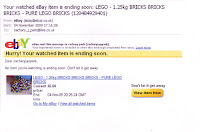
We then searched on Amazon. However Amazon had a more niche market and the prices where a lot more expensive than anticipated.
We also spoke to our parents asking if we had Lego but we found out they had thrown them away when we were younger. Zac e-mailed our old media teacher Kate Wolstenholme and asked her if she had any Lego as she has kids. Unfortunately she hardly had any and only had Star Wars characters which we didn't want as it wasn't the mise-en-scene we needed.
Finally we decided to look for Lego in shops in town like Argos and Entertainer. We found a decent villain in the Entertainer but it was expensive but we knew it would be cheaper than buying it online and it would save us time to get it now. It was a "power mining" Lego toy and cost £8 so we payed £4 each. There was one problem caused from this and that was the villain was green which meant we couldn't use the green screen card as they were the same colour and the villain would be erased out when putting in a background on the computer. We have now agreed to use blue screen for the time being.

We continued to look on Ebay and eventually we found a "Fire mans" play set which had enough bricks and never had blue in it so it wouldn't contrast with the blue screen which is ideal. It also came with Lego people which we could use as they were basic. The cost was £15.97 which was around £8 each.
Yesterday Zac was talking to one of his teachers and she said she had lots of Lego at home which she would let us borrow. Also she said if we borrow it can we sell the rest of the Lego we bought to her. This is great as we can make a profit and we now have most the Lego we need for filming. Zac plans to pick up the Lego next Friday at 11:30.
Below is the e-mail sent to Zac by his support teacher about the Lego:
Hi Zac I have heard that you are looking to source some original Lego for your filming. I have quite an assortment of bricks and models if you are interested. When you have finished with all your Lego it would be appreciated if I could have first refusal on purchasing it. Sue Wilson
Preparation for Lego filming
We booked out the lights for our filming on Friday the 27th. Zac pick the lights up at 12 50.
Zac took the lights home in his car as he passed his driving test in the summer holidays.
Green screen
Zac went to the arts shop in Worcester PHW on the high street and looked for colored card. He found there was loads of different colours, but eventually bought orange, silver and a light blue cards.
Orange
The orange was really bright but it did blend into the red too much. It also gave a very bad contrast to some of the lighter colours.
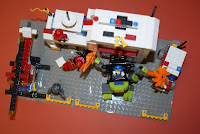
The colour silver worked very well. The shadow was limited to bar minimum and took most of it off straight away. The only colour that was like it was white however this worked well. Until we realised that the Lego character we used was silver/grey.Therefore this blended into the background.
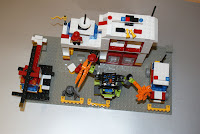
This worked well because the only colour blue we used was see-through dark blue. Which didn’t really affect the background. The shadow from this card did make a fair amount of shadow however this wasn't a problem with the high powered lights.
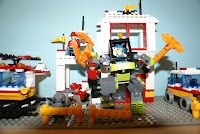
I and Zac agreed to meet at Elgar statue at 1 on Sunday the 29th of October.
We set the lights up and placed the blue screen ready where we wanted it to be placed. We tested different places but found the best location was on a draw in the corner as there was no shadow when the lights shone on it. The format we used on the lights we found out that the shadow we got was behind most of the main area so we moved one of the main lights to the back taking the shadow off.
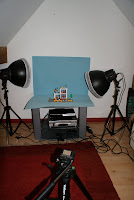
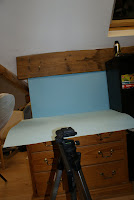
Saturday, 17 October 2009
Planning our film in detail
We meet on the Tuesday before half term as we needed to get a tape for our film as Zac and I forget to get one from the college. We went into town and discovered that you couldn’t buy a separate tape on its own so we had to buy a pack; the price was from £12-20. We looked in all the shops of high street media conglomerates such as Comet, Currys and Jessops. Zac was the one with the money and decided to get the Sony tapes which cost £12. This made our budget increase to £32.
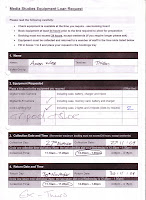
We had all he logistic arrangements organised and I was at collage Jordon and the equipment. Zac arrived at collage at about 11.15 he had went into town to get the tape. When he arrived we went to see if any of the rooms were unlocked in the college so we could use them to but as expected the rooms where locked. We wanted our shots to be filmed in chronological order so then I decided we should use the library as it was open and there is an area at the back which is like a classroom. We had to ask for permission from the librarians but they were really nice and let us.
Battery
Just as we set everything out and were ready to film I realised that we only had one battery and it was very low on power. Zac spent 15 minutes looking for our media technician Ian who looks after all the equipment. In the end he found him but he didn’t have a key to the media room which had all the equipment in. While Ian went looking for a technician we had the chance to plan out what we were going to do and eventually Ian turned up with a spare battery for us. He also gave us a battery charger so I charged the dead one and used the other one so we could keep crossing over between the two batteries to get us through the day.
Finally we could start filming and we followed the storyboard step by step. We also came up with some new shots we didn’t include in the storyboard which we were pleased about. We Filmed every shot atleast five times from different angles so we could chose the best shot at the end. This was experience from which me and Zac had learnt last year from the chance of getting a jump shot,180 rule or having a bland range of shots if you only had one shot for each scene.
We knew where the janitor’s classroom was and when we were finished filming in the LRC we went to him and had had keys to open a classroom door for us as we needed it to film our next scene.
It took 4 hours to film everything we wanted and we ended up with 2 and a half minutes of film which we need to cut down to around 30 seconds. Overall I enjoyed filming and everything went according to plan apart from the battery issue which we eventually sorted out. Jordon was good and helped us a lot he even tried to come up with some of his own ideas!
We have now decided on the first Monday back we will scan all of work in like storyboards and pictures and upload them to the blog.
Friday, 16 October 2009
More Planning
We have agreed that our character wakes up in an empty classroom in the college after permission from the janitors. We used shots like pan and long shots of the environment to show the new world the Main character has entered. The fact the main character is confusion is demonstrated by close ups and hand held camera shots which we agreed on using.
The last shot we came up with is the main character sat at a desk in a room with a voice over saying episode one with it written on a white board that is turned over to show the audience. This is going to change every week a different episode number and name.
Below is a shot list of the type of shots we are thinking of using and how long each shot will be:
Shot list
High angle long shot-2 seconds
High angle close up-1 second
Mid long shot-3 seconds
Point of view shot-4 seconds
Medium shot-3 seconds
Hand held/Depth of focus-5 seconds
Long shot-4 seconds
Long shot-5 seconds
Mid shot-2 seconds
Long shot-3 seconds
Hand held/pan 360-8 seconds
Long shot-3 seconds
Close up-2 seconds
Voice over planning
If everything goes according to plan when we finished filming the visual context in the half term we can upload the video and start editing. This is important as it gives some idea of how long we need to make the stop frame animation.
Before we do the voice over we will need to make a script.
However we have to wait until we’ve finished the editing and the stop frame animation to give us the duration of the editing sequence. We are hoping to get this done in brief in October so we can focus on the stop frame animation.
Thursday, 15 October 2009
Planning: Letters and e-mails
MR Zachary Jay Park
Himley House
112 Ombersley house
Worcester
Wr3 7EZ
Home number;01905 20270
Mobile: 07825212230
Mr and Mrs Wise
1 Coltishall close
Worcester
WR5 3RF
Dear Mr and Mrs Wise
I am writing this letter to ask if I may use your son Jordan Wise in the production of our TV Drama. We will contact you to arrange when we will need him and give dates and times. He will be the main character and will have to play a big role in the drama. However he will not be involved in any sort of antisocial behaviour and will be looked after.
Yours sincerely Aaron Wise and Zachary Park
The letter above has been sent to the parents of the actor asking if we can use him in the making of our Children's TV Drama. I will blog the reply we get.
LEA: Worcestershire
Telephone Number: 01905 354154
Fax Number: 01905 354154
Address: Prestwich Avenue Worcester
Post Code: WR5 1QE
MR Zachary Jay Park
Himley House
112 Ombersley house
Worcester
Wr3 7EZ
Home number;01905 20270
Mobile: 07825212230
Dear Mr/Mrs
We are writing Worcester sixth form A2 media students. Our media coursework is to develop and create the opening of a children’s TV drama. We are writing to ask if we can give out some questionnaires to your members of staff, which they could give out to the children to complete. We could then collect them from staff at the end of the day. The questionnaire is very simple and consists of questions like “when do you watch TV” and “what TV channels do you watch”. We would like to hand out 40 questionnaires but 10 to each year from year 3 to year 6. This is because that is our target audience for the making of the TV drama. We would really appreciate it if you take this idea on board and it would help us greatly to achieve our project. Hope this didn’t take up to much of your time and we look forward to hearing from you
Yours sincerely Zachary Jay Park and Aaron Gregory Wise, Media Sixth form students
This letter has been sent to Nunnery Wood Primary School asking if we can give out questionnaires to the students there, which is our target audience as we want to get some direct feedback. I will also blog the reply we get.
Hello,
I am a media studies student at Worcester Sixth Form College. For my coursework this year me and my partner are making a Children's TV Drama. We would like to know if we can film on school site during half term. Not inside but outside on the playground. It would only take a day and would really help us complete our coursework. Sorry for taking up your time and I look forward from hearing from you.
Yours sincerely Aaron Wise
This is an e mail I've sent to Nunnery Wood High School asking if we can film on site during half term. I will blog the reply I get.
I and Zac spoke to the janitor to see if Worcester sixth form collage was open in the half term.
Here are the minutes of the convocation
Zac: hello
Janitor: hello, what can I do for you?
Aaron: we are looking to film our media coursework in the holidays and I was just wondering if the collage was open and if any rooms were.
Janitor: collage will be open every day from 9-5. If you’re looking to get into any rooms ask one of the janitors around collage or reception where you want to go.
Zac: alright thank you
With this in mind we now know the college is open in half term and we can use it for filming we
just need to figure out what day we are going to film on.
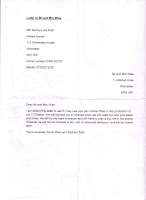

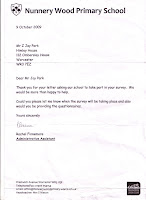
Wednesday, 14 October 2009
Practising making our Drama #2
Things were very different this time round mainly because we had Lego. Also we booked the photography room where the actual filming of the Lego animation will take place. This has advantages as we will be able to set everything up much quicker as we've had practise. We used the same lights but this time we used four instead of three to get rid of all the shadows. We also used the same camera and method as last time round. However the filming took place on a small stage a few center metres above floor level so everything had to face downwards. We had to cover the floor and walls with green screen so we could change the background later on Adobe Premiere Pro 2.0. The same rules applied as last time, as Zack took the shots and I moved the Lego. It took just under an hour to film and was harder than last time as there was more objects to move and because they were so small they kept falling over which was a pain as we couldn't put it back in the exact position. In some shots I used blue tack to hold up certain objects that were flimsy this was good as you couldn't see the blue tack and it worked effectively. After filming and putting the movie on Adobe Premiere Pro 2.0 we could see there weren't as much problems but there was one main one. Firstly we still had the shadow problem but that was because there were several other people in the small room with us practising but obviously in the real thing we will be filming alone. Another small issue was you could see the green screen line going across the film. But again in the real thing we would tape this down so you wont see it. The big problem we had though, was the camera going in and out of focus. This wasn't Zack's fault as he didn't no, but we now realise that to avoid this we have to keep changing the camera focus every time an object moves towards or away from the camera to get a clear picture.
This is the link to the second practise we did:
http://www.youtube.com/watch?v=Ts85OZaZLW4
After practising for a second time I can see we have improved but also encountered new problems so we must be aware at all times if we want our Lego animation to be a success.
Overall I feel more and more confident with the more practise we do and I am looking forward to filming the real thing as it will be a new and exciting experience for us.
Practising making our Drama
Today we practised using Stop Motion Animation for the first time which had some positives and negatives.
Firstly we set up a setting where the filming would take place using the back wall of our media class and green screen. This was easy to do but then we had to set up three lights all at different angles around the table. This took us a while but we have to be very careful with lighting equipment as you can get hurt using them inappropriately. After setting up the lighting equipment we got a Nikon D60 DSLR camera with a tripod and placed it a few centre metres from the table. Once we had every thing in place we needed something to film. We chose a remote used to work the whiteboard as we didn't have any Lego. When we placed the remote on the green screen and turned the lights and camera on we could see straight away there was a big problem. The remote had shadows all round it, this is a problem because when the film goes on Adobe Premiere Pro 2.0 and we replace the green screen for a background of our choice the shadows will still be there. So we had to play around with the lights a lot until we got rid of the shadows on the remote. Once we had done this we could begin to film, Zack took the pictures on the camera and I had to very slowly move the remote across the green screen after every shot he took. This took around 20 minutes to do a few seconds clip so you have to have a lot of patients. After doing this we had to follow the following instructions:
# Press the menu button on the back of the camera
# Press the down arrow, then OK to select "retouch" menu
# Press the down arrow again and OK to select the "stop motion movie" option
# Press OK to select "create movie"
# Select your starting and finishing image using directional arrows and the OK button
# Press OK to save, then OK again to preview
After viewing our short film we could see there were a few problems, such as:
1- Still shadows reflecting off the remote
2- Shadows of my reflection were in a few shots
3- remote being moved to fast and jump cuts were obvious
4- In one or two shots my hand was in the shot because the picture was taken to quickly
We have to learn from these mistakes and in our next practise we aim to avoid all of them. We can do this by taking our time when taking shots and the person moving the object should step a metre away from the setting so there shadow will not reflect off the lights.
We got rid of the frames we didn't want by selecting "edit" after viewing the film. We then removed the SD card from the camera and put it in a computer. We then opened up Adobe Premiere Pro 2.0 where we selected file then import to get our animation which had a .avi file in drive "p".
Once we did this we could experiment with the tools on the software. We removed the shadows using the fade tool and then turned the green screen red by selecting colour background.
Overall we have had a lot of fun using Stop Motion Animation and have learnt a lot like how we will avoid the mistakes we've made and how we are going to use this in our Children's TV Drama. In my next blog post I will be talking about how we did this again but with Lego.
This is the link to our first practise using Stop Motion Animation:
http://www.youtube.com/watch?v=znJDznjrM0w
Am I a Auteur?
French Film directors in the 1950s like Francois Truffaut advocated a focus on the contribution made by the director on the style and from of a film. This is in direct contrast with other perspectives on film which advocate looking at how the film develops as part of a generic history. Also auteur theory differs to "Genre theory" in that it points our attention towards what is different between films, rather than what is similar. Clearly many media texts are meant to be considered as products of individual creativity and many are simply "products".
Genre Theory focuses on:
# Generic similarities
# How texts are determined by historical/social/political contexts
# How texts emerge as commercial products from an industry
Auteur Theory focuses on:
# Individual stylistic features
# How texts are determined by artists creativity
# How texts emerge as part of an artists body of work
Looking back at my AS coursework I can see it was very generic as I wanted to use a lot of conventions from real media texts. However this year I still think my work is generic in some ways as I've looked at conventions from real media texts, but I also have put my on unique twists in.
This year my work is very original as me and my partner are thinking up new ideas which haven't been used before. Just like in my coursework last year we followed a simple plot then shocked the audience by throwing in a twist at the end. This year the same idea applies as I am a person who likes to shock the audience when watching something generic.
Therefore I believe I am an "Auteur" as I like to use my own ideas my work. Looking at the idea of "Auteur's" has been interesting and has given me ideas of how we could develop our idea even further.
Tuesday, 13 October 2009
Redundancy and Entropy
I believe Redundancy is something which is very predictable and makes effective communication with the audience like a picture of a dog. I believe Entropy is the opposite to Redundancy and is unpredictable. It is something you wouldn't expect and might not make sense like a picture of humans with cat heads.
Linking these theories in with our own coursework I can see that we use elements of both Redundancy and Entropy.
Our idea has Redundancy as it is set in a school and is about school life which relates to the target audience who are also in education. Therefore the whole idea of a school is predictable and will be expected by the target audience.
However our idea also has elements of Entropy as we are involving Lego. Lego itself has Redundancy but we have mixed it in with real life and we are making a Lego character turn into a human boy which is very unpredictable and not expected. On a scale of 1-10 we think our idea is bang on 5 as we involve a lot of simple ideas like school and twisted ideas like Lego turning to human in our plot.
The concept of genre:
Looking at our idea I can see that the genre has elements of Redundancy more than Entropy. As we are doing a Children's TV Drama we went for the most obvious genre "Drama" because after doing some target research we saw that "Dramas" are the most common and viewed genre. We wanted to attract the widest audience within our target audience so we "played it safe" by going for the most common genre. Because "Drama" is the most common Children's TV genre it has Redundancy as it is expected and predictable.
The concept of creativity:
We also looked at how creative our idea was and whether our creativity had elements of Redundancy or Entropy. I think our idea has certain elements of creativity that is redundancy such as like I've said above with the school being related to the target audience. This has elements of redundancy as it is predictable that a Children's TV Drama based on a school is aimed at children who go to school. However we really wanted to involve elements of entropy within our creativity which I think we have achieved as we have mixed Lego with humans. It is very unpredictable that a world of crime fighting Lego jumps to a boy at his first day in high school.
The concept of using conventions from real media texts:
Finally we looked at how our idea uses conventions from real media texts and whether these ideas are have elements of Redundancy or Entropy. We used conventions from real media texts such as "Life on Mars" and "My parents are aliens". These two TV programmes have a large proportion of Entropy in them as they mix different ideas together like the present and the past and aliens and humans to make a brand new idea, so you could say our idea is mainly Entropy as we've taken conventions from these programmes. However as we are using some the same conventions from these programmes you could say our idea has elements of Redundancy as we are reusing ideas and therefore it is predictable and expected.
Overall we want our Children's TV Drama to have elements of both Redundancy and Entropy as we want to give the target audience something they can relate to but also be different with certain twists giving them the chance to see something new.
Pitch Comments
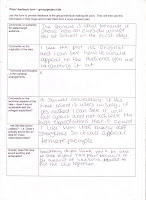
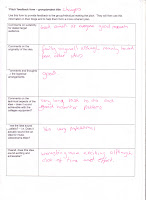
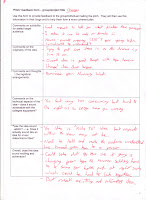
#Comments on suitability for stated target audience- 11 out of 14 students said we chose a suitable target audience and said that it was good how we are using the main character to relate to the target audience. However some people said the target audience is to wide and that the drama should be aired during school time as well. Taking this into consideration we might narrow the target audience a little from 5-11 maybe to 8-11. However doing this will mean losing a large proportion of our target audience which we do not want as we will lose a lot of profit. Also showing the Children's TV Drama before school finishes would mean losing over 2/3 of our viewers which we cant risk so we will stick with showing the drama just after school finishes.
#Comments on the originality of the idea- 12 out of 14 students said they think the idea is very original and mixing Lego animation with real people is a very strong original idea. This for us is the green light to go forward with the idea as it is very positive feedback. However two students said the plot sounds a little bit complicated for a young target audience. This is a fair point and with this in mind we may twist the plot a little bit by taking the "super hero" out of it to make it more simple.
#Comments and thoughts on the logistical arrangements- 11 out of 14 students said we are organised and have good logistical arrangements. last years coursework I was very good with logistical arrangements and I wanted to maintain that strength this year which I think I achieve achieved. However three students said how are we going to get permission to film in Nunnery Wood High School. We have already thought about this and told them we will be sending them letter asking if we can film there outside school hours during half term which they thought was a good idea.
#Comments on the technical aspects of the idea- Every student said the idea is achievable with the equipment were using which is a huge positive for us as it shows we are organised and know what were doing because we have already planned and thought about what equipment were using and whether we can access it. However 5 students were a little bit concerned with time management. They thought we might not be able to finish before the deadline. We have also thought about this but no if we buckle down and put a lot of time into it over the next few weeks we can get it done. Time Management is not an issue to us.
#comments on whether the idea sound realistic- Every student said the idea was realistic and achievable as we have put a lot of thought into market research within the pitch. Like I said above this means a lot to me and my partner and we will definitely stick with the idea were going for. However linked with these comments a few students think it will be hard to make a Lego person turn into a real person. We know this will be hard to do and it probably wouldn't be achievable just using jump cuts. This is why we are using Adobe Premiere Pro 2.0 on the computer to help us make the scenes more realistic.
#Comments on how exciting the idea is- Every student thought our idea was exciting and there was no negative feedback about whether it was interesting. Most of them said if they were the target audience they would watch it as its different and interesting. This is what we were aiming to do, create a plot that will attract the target audience because its so different and interesting so we are really happy with the feedback.
Overall the feedback we received from the rest of the class were around 90% positive so we are really grateful and know we are going in the right direction with this idea. We have taken all comments on the chest and will think about them carefully as we don't want to slip up at this stage. At the moment our idea is coming on leaps and bounds we just have to maintain this.
Our teacher Tristan also gave us feedback after we presented the pitch. His comments weren't like the students as he only spoke about what we need to do to improve our idea. He said we will need to write a letter to Nunnery Wood High School asking for permission to use the school for filming. We told him we already thought about writing a letter and he also said to write a letter to Lego asking if we can use its product in our film, which we also told him we will be doing. He said his friends made a Children's TV Drama using "jellybabies", they were allowed to call it jellybabies in the USA but because its copyright in the UK they had to change the name to jellykins and he didn't want us having the same problem if we never contacted Lego. He asked us where will we be filming the Lego animation and we told him we will be booking to photography studio which he thought was good place as its quiet and has lighting equipment. Finally he told us he was worried about our time management. He told us if we want to make the drama achievable we have to start quickly and use the time wisely, which we intend to do.
After receiving all these comments we are sticking to our idea and pushing forward full throttle.
Monday, 12 October 2009
Planning: Time Schedule
2.What needs to done
3.Is it achieved?
1.Week being 19th -22nd
2.We prepare story board and get logistic organised for filming
3.Yes
1.22nd of October 2009
2.Book out camera etc
3.yes
1.24th of October 2009
2.Agreed on date of filming Tuesday 27th of October 2009 outside Worcester Sixth form college
3.Yes
1.26th of October 2009
2.Zac needs to buy a video tape
3.No will get it before filming on the 22
1.27th of October 2009
2.Filming
3.Yes
1.Beginning of November 2009
2.Start of editing process
3. Yes
1.2nd -10th of November 2009
2.Look for Lego and prepare to logistic arguments for it
3.This has been delayed because of the problem of finding the Lego, however while this problem has happened we have continued to edit our film.We believe that we will start green greening by the 29th after editing has finished.
1.29th of November
2.Make sure everything Is ready for filming and possible start of filming.
3.This was done and everything was set up ready for filming.
Planning
Equipment
The equipment we are using is going to be kept at my house because I live closer to collage than my partner Zac.
Using the digital video camera
We booked the equipment out on the 22 of October. This included tri-pod, camera and spare batteries.
Green screen
We will coloured card to go at the back of our Stop Motion Animation .So we can digitally put a background on of our choice using Adobe Premiere Pro 2 when put on the computer. The SLR camera we will use will be Zacs own camera because he knows it very well and feels more comfortable with it.
Other equipment
Lego and lighting equipment which we will look need to look at so we can figure out dates when we can book the equipment out and buy Lego.
Location
In our work by using the narrative of our children’s TV Drama we had set allot of our work inside a school with the first couple of shots. We have written a letter to nunnery Wood high school asking if we could use the premises to film.
I and Zac had a conversation over msn to agree the meeting and the date of when we were going to film our media coursework. We agreed to film it on the Tuesday 26 of October and agreed to meet outside Worcester Sixth Form collage at 11. We checked the weather report and the weather were meant to have cloud with the chance of showers throughout the day. However we had most of our shots inside this was still important to talk about because we had to get the equipment to and from collage.
Actors
Because of the two different methods we were using we only need to use one actor as the main character in our work. Because of preferred target market being 6-11, we agreed to have a actor aged 11 so a younger audience could look up to them and see them as a role model and see what higher education actually seemed like for further years of their lives. We agreed to ask my younger brother (Jordon) if we could include him in our piece of work. Because of the actor being fewer than 16 we had to write a letter to the parents of Jordon to ask for parental consent. We have agreed not to have any talking in the start and have a voice over of the whole piece of the work because it makes it easier for us to explain the change that’s happened to a new member of the audience watching the programme for the first time. We don’t think we need to include a voice of an 11 year old because we think we can use an older voice to make it sound more professional and clear.
Custom
Because of the Lego character we are basically going to try getting a Lego super hero for a main character. In the second half of our piece of work Jordon would be wearing the Nunnery Wood school uniform. This uniform links with change of clothing and the audience will recognise the school uniform and relate to the main character.
All these things we have looked at and are dealing with currently. To keep track of our work and progress we have created a time schedule which you will see in my next blog post.
Sunday, 11 October 2009
Treatment
"Changes" influenced by the David Bowie song like "life on Mars"
http://www.youtube.com/watch?v=pl3vxEudif8
Concept:
A 30 second opening sequence of a Children's TV Drama under Lego animation
Purpose:
To be accepted by the CBBC as a Children's TV Drama
Desired Outcome:
To attract the target audience into viewing the drama and make a large profit
Genre:
Drama as after doing lots of research they are the most successful Children's TV programme.
Social class:
C1 as it is aimed at a young working audience
Target Audience:
5-11 because we want a target audience that are still in education and are about to or have started secondary school.
Narrative:
In the world of Lego a young superhero is transformed into a human after being shot with a human ray gun from an evil villain. He wakes up in a classroom as an 11 year old boy and finds out its his first day of secondary school. He must learn to adapt to school life and face any challenges in his way if he wants to return to his old life.
Influences and challenges:
Our idea was influenced by the British TV Drama "Life on Mars" as we liked the idea of someone being taken out of their comfort zone and having to learn to live a new life which our Children's TV Drama is all about. Another influence is from the Children's TV Drama "My parents are aliens". We liked the idea of a "alien" being thrown into everyday life and seeing how they would cope and how others around them would react.
However our idea challenges Children's Drama's like "Grange Hill" as we don't want ours to be typical and original like "Grange Hill" (a normal school life). We want to twist ours so the target audience will get something different and special to see which will hopefully increase the target audience!
Technology:
We will be using lots of different and new equipment during the making of the Children's TV Drama as we want to experiment and develop our skills.
All the following technology will accessed by the media department in college:
# Lighting- used in both Lego animation scenes and real life scenes
# SLR camera- used to film the Children's TV Drama
# Green screen- used as the background setting for the filming of the Lego animation
# Computer- used to upload the Children's TV Drama and finalise using Premiere Pro
Logistical Issues and Arrangements:
#Transport: All filming is being done in Worcester and with me and my partner Zack living less than mile away communication is not a problem. Filming will be done in two locations, one a school and one a college next to each other so moving equipment round like lighting wont be a problem. We both live less than a mile away from the college and school and would be able to walk there in less than 40 minutes from our homes so transport is not a major issue.
#Props/Clothing: As the drama revolves around a school we will need to use tables and chairs which shouldn't be an issue as long as we ask. Also we will need a school uniform for the main actor. This shouldn't be a problem to as my 11 year old brother is a student at the high school we are filming in so we can use his school uniform and everyone else will be wearing the same uniform giving a more real approach. Our main prop will be the Lego were using in the drama. We wont need allot but we will need a Lego setting and Lego characters to complete the Drama. I have some old Lego but not allot; were thinking of buying some.
#Lighting: We are going to book the lighting equipment and film in and outside college hours. The lighting equipment is free to use which is a bonus and we have had practise on how to handle the equipment appropriately in the past. We will be using the lighting equipment in all scenes of the drama including Lego animation as we wouldn't like unwanted shadows.
#Actors: We only need one key actor to play the role of the human boy who was once Lego. As we are only filming the opening sequence of the Children's TV Drama we believe only one actor is necessary as more than one will mean more recruiting and this would waste our valuable time. We already have the actor in mind to play the role and it didn't take long to think why. My younger brother Jordan is 11 and has just started high school just like the boy in our drama so it shouldn't be a problem fitting in as the role of the character. He has done allot of acting in stage performances abroad and at school so he knows what hes doing and will be very professional. He is experiencing high school life and can give us details of what he has to cope with which will benefit us when making the drama. He is willing to give anything a go and he would travel with me so transport isn't a problem. All we have to do is write a letter to my mum and dad asking for the permission of using him in our Children's TV Drama.
#Locations: We will be filming in two locations. One location will be Nunnery Wood High School, this is the setting you will see in the drama. We will need permission to film there so we will send a letter asking if we can film on site. My brother is currently a student there and I was once a student there and we know the staff really well so we should be able to use the school when filming.
Our second location is Worcester Sixth Form College. This is the location you will not see in the drama as its the setting for the Lego animation. We have booked the photography rooms which are big black rooms with cameras and lighting equipment. The reason you wont see the photography room in the drama is because we are creating a mini Lego setting and placing this on green screen. So when we have finished filming and put the film on the computer we can choose a artificial background to suit the atmosphere of the scene.
#Letters: Me and my partner have to send out a few letters asking for permission to do things such as:
1st Letter- A letter being sent to my parents asking if we can use my younger brother for the production of the drama.
2nd Letter- A letter being sent to Nunnery Wood High School asking if we can film our drama on site not during school hours.
3rd Letter- A letter being sent to Lego asking if we can use there products in our Children's TV Drama.
4th Letter- The final letter is being sent to Nunnery Wood Primary School asking if we can give out questionnaires to year 3-6 which is our target audience, so we can get some feedback and make changes to our ideas if necessary. We have designed a questionnaire which we hope to hand out to our target audience. It only has 5 questions as we don't want loose the kids attention. The questionnaires are very simple like "which TV programmes do you watch" and "when do you watch TV". From this we can get some interesting information and use it to alter our drama to suit the target audience and also increase the target audience.
Costs of the Production: We are very lucky when it comes to costs as we don't need to pay for transport, equipment, settings, props/clothing or even the actor! However we will have to buy some Lego as we don't really have any and don't know anyone who does. We will try to buy some off eBay as it will be cheap, we don't aim to spend over £20.
Timescale of Events and Deadlines: We will be filming the drama over half term from the 24th of October to the 2nd of November and aim to finish within at least two weeks. The filming at Nunnery Wood High School should take about a day or two also the filming of the Lego animation should take around a day to film. However after those few days it will take over a week to edit and change on Adobe Premiere Pro 2.0. Before half term we will be practising using green screen and stop motion animation which I will upload to the blog saying how I got on.Health and Safety-Risk Assessment:
We have thought about what could go wrong over the coursework and have thought of a few possible solutions.
#Breaking the equipment/Injured by the equipment- Be very careful when handling the equipment and always use and transport the equipment in pairs. If anyone is injured we have access to first aid kits in both Nunnery Wood High School and Nunnery Wood Primary School.
#Someone getting injured- Like I stated above we have access to first aid kits but if the injury is that severe we will have mobiles to phone the hospital which is only less than 5 minutes away from where were filming.
#Someone getting lost- This should be easily prevented as we will always stay together and we will all have mobiles phones with each others numbers so we can meet up with the rest of the group if we get lost.
#Fire- This is very rare, however it can happen. If there is a fire in the location were filming at we will evacuate the location immediately and meet at a large open spaced area outside.
Overall I believe the final idea is simple as it is not to complicated but very effective as it relates specifically to the target audience which we wanted to achieve.
Below is the link to the pitch:
http://www.slideshare.net/AaronWise240/introduction-of-pitch1
Final 3 Ideas and more Research
1st idea:
A 11 year old boy starting his first day of school is transformed into Lego after being hit by a football. He wakes up as a Lego boy who must adapt to Lego life if he wants to return home again.
This idea came from a mixture of wanting to do animation and he British hit TV drama "Life on Mars".
http://www.youtube.com/watch?v=vavHlnztnuo
We chose this idea as we like the idea of someone entering a environment there not familiar with but must learn to adapt to it like a child starting a secondary school so they can relate and learn from it which should get more viewers.
However we think this is our weakest idea as we no Lego is copyright and we will have to ask for permission to use it through e mail or letter. Also a Lego drama is not a TV drama as it must have elements of real people and a whole drama on Lego does not support this.
2nd Idea:
A 11 year old boy starts high school and makes new friends. However he finds there seems to be problems behind every corner such as evil teachers and bully's. So he and his friends work together to solve the problems.
This idea came from the Nickelodeon drama "Ned's Declassified School Survival Guide".
http://www.youtube.com/watch?v=lQYmJctb-TQ
We liked this idea as it also was about school life and children could relate to it in several ways like how to make new friends and how to avoid evil teachers.
However the problem with this idea is it is very original and doesn't really challenge anything plus we wanted to use animation which we wouldn't be able to do. Also we would need to film in a school during school time so we can make it as real as possible. But this would be very tricky as We don't think a school would let us film on site during school hours regardless of sending a letter or e mail. Another reason why this idea would be hard is the children wouldn't be themselves if we had a camera in front of there face.
3rd Idea:
In a world of Lego a young superhero is shot by a evil villain with a human ray gun. This transforms the the superhero into a human boy who must now go to school and learn what its like to not only to be a human but to adapt to secondary school.
This idea is the opposite of the first idea but with a twist. We wanted to mix animation and school life together and we thought this was the best way. The same problems as the first idea still apply but this time it is a TV drama and with the following we can develop this idea:
# Lego characters and Lego setting
# Actors from high school
# Appropriate lighting
# School location
# Stop motion Animation
Our final idea will be announced in my next blog post under the Treatment.
Research
If I am going to use Lego In my Childrens TV Drama, I will need to look at how lego works with stop motion animation.
Here are a few fantastic sites I have looked at which will really help me if I chose to do Lego stop motion animation in my Childrens TV Drama:
http://tryit.adobe.com/uk/director/?sdid=ENNBM
http://www.filmschoolexposed.com/?gclid=CIGWmdSqqJ0CFVtn4wodIA5Yiw
http://www.babelgum.com/html/clip.php?clipId=3021374&gclid=CPSO3tyqqJ0CFZQA4wodfk-Jkg
http://www.stopmotionpro.com/
http://nfb.ca/explore-by/title/?title_range=All&lang=en&genre=2&decade=&time_range=?ac=g+animatedfilms
http://www.brickfilms.com
Saturday, 10 October 2009
Team Work
At this stage we have came up with a rough idea of what our Children's TV Drama will be about.
We both like the idea of animation being linked in with real children like the Tracy Beaker opening sequence. We are thinking of using Lego animation as it lets us experiment with new technology such as stop motion animation which will develop our skills in different aspects of media. Below is a rough idea of what our drama might be about.
Narrative:
A boy starting his first day of high school is turned into Lego after being hit by a football. He is permanently stuck as a Lego boy and must learn how adapt to Lego life.
Already we know that this idea will cause problems due to Lego being copyright and whether a Lego drama is a TV drama . But as Ive said before this is just a rough idea and we are thinking of many more before we produce our treatment where we will have only one idea which we will stick with.
Research: What I have found out about Childrens TV Dramas
#On average about 30 seconds long -Grange Hill
#Tells the narrative of the drama in the opening -My parents are aliens
#Fast paced editing -Tracy Beaker
#Voice overs -Neds declassified school survival guide
#Loud non-diagetic music -Doctor Who
#Aspire to be older than they are -M.I. High
#Lots of different camera shots - Neds declassified school survival guide
#Animation and borders -Neds declassified school survival guide
#Bright colours -Drake and Josh
#Young Actors -Tracy Beaker
These are all very common features in openings to Children's TV Dramas, I will take all of these into consideration and try to include as much as I can in my Children's TV Drama as I want to attract a young target audience of around 5-11 and at the same time be very successful.
Planning and Research
I will need to recruit actors and with this in mind they will most likely be children so the target audience can relate to them. I haven't thought of a specific target audience yet but I no it will be young as I want the Drama to relate to the audience in some way. If I want actors under 16 I will have to send letters to the parents of the child asking for permission to use there child for the filming of my drama.
I will have to be very organised with times and dates as I don't have a lot of time and I want to get the best possible outcome from the making of this drama and while completing the coursework I want to learn how to use new equipment and prepare myself for the exam next summer.
I have also been thinking about locations which will be very hard to decide on as every location has a different atmosphere. At the moment I think the most ideal location would probably be in a school environment as its an everyday experience in children's lives.
Below are a few rough ideas I have thought of for locations.
Children’s TV opening
Firstly I’m going to look at my target market. The target market for a child is between the ages 0-18. This means its going to be really hard to appeal to the target market as most kids from 16-18 like adult TV dramas as well.
What is a child?
A child is a human being between the stages of birth and puberty. The legal definition of "child" generally refers to a minor, otherwise known as a person younger than the age of majority. "Child" may also describe a relationship with a parent or authority figure.
Brief history of TV drama shown on Wikipedia
The history of children’s TV dramas started with the BBC in the 1950s. These dramas were for large based audiences not just the target market. The first children’s TV dramas where front loaded by books, Most of these early productions were adaptations of turn of the century literary standards such as Little Women (BBC, 1950) and The Railway Children (BBC, 1951, 1957, 1968), there therefore resulted in the children turning channel to ITV.ITV at this time was offering a more adventurous children’s TV drama the adventures of Robin Hood (1955-60).
After this failure of the BBC children’s drams they gave up on this department and its funding was given to adult TV dramas. As for the time since the BBC were not funding children TV dramas, ITV were still leading the way with Enid Byton’s Famous Five and Secret Seven. These were books which were a series of 21 individual books. BBC had come back with a small budget series called Carrie's War in 1974 however this was still a front loaded series based on the origins of an authors work. This was one of the series which made children’s TV drama a more emotional piece rather than just a happy programme where nothing went wrong ,this triggered the change in the way how Children’s TV dramas where shown.
In the mid 70s the change for children’s TV dramas changed when they became more charactieristics of the children who watch the programmes, so as a result the realism was more working class characters. The late 70s had some of the huge successes such as Golden hill (ITV, 1975) which featured a local gang and its council and ‘while A Bunch of Fives’ (ITV, 1977-78). At this time the BBC launched one of the most famous and long running children TV dramas Grange Hill (BBC, 1978-present), which dealed with real issues they faced such as bulling, drugs and under age pregnancy.
The golden age for the children’s dramas has at its peck with both ITV and BBC coming out with some more unusual programmes including fantasy and sci-fi children TV drama. ITV was doing a special drama which was just aimed for a children’s market.
In the mid 80s the BBC was at a peak turning out series after series of British TV drama, they and a series called a box of delight (BBC 1984) which was a spin off series of the chronicles of Narnia. These were supported by the help of America funding. The BBC had following successful series which had hits in America such as Tom’s Midnight Garden (BBC, 1989), The Borrowers (BBC, 1992-3) and The Phoenix and the Carpet (BBC, 1997).
In 1989 BBC put on air Byker Grove, which was about a youth club. This therefore was queried if it was more like a soap opera rather than a children’s TV drama. The BBC was turning out 20 episodes a year which was dominating the market with spin off series of selected characters of play in real life. The change the BBC had made they were making programmes the Children could relate to.







